
The Democratic Republic of the Congo (DRC) is the largest country of sub-Saharan Africa, occupying some 2,344,858 square kilometres (905,355 sq mi). Most of the country lies within the vast hollow of the Congo River basin. The vast, low-lying central area is a plateau-shaped basin sloping toward the west, covered by tropical rainforest and criss-crossed by rivers. The forest center is surrounded by mountainous terraces in the west, plateaus merging into savannas in the south and southwest. Dense grasslands extend beyond the Congo River in the north. High mountains of the Ruwenzori Range are found on the eastern borders with Rwanda and Uganda.

Papilio machaon, the Old World swallowtail, is a butterfly of the family Papilionidae. The butterfly is also known as the common yellow swallowtail or simply the swallowtail. It is the type species of the genus Papilio. This widespread species is found in much of the Palearctic and in North America.

The African river martin is a passerine bird, one of two members of the river martin subfamily of the swallow family, Hirundinidae. When discovered, it was not initially recognised as a swallow, and its structural differences from most of its relatives, including its stout bill and robust legs and feet, have led to its current placement in a separate subfamily shared only with the Asian white-eyed river martin. The African river martin is a large swallow, mainly black with a blue-green gloss to the head and a greener tint to the back and wings. The under-wings are brownish, the underparts are purple-black, and the flight feathers are black. This martin has red eyes, a broad orange-red bill and a black, square tail. Young birds are similar in appearance to the adults, but have browner plumage. This species has a variety of unmusical calls, and displays both in flight and on the ground, although the purpose of the terrestrial display is unknown.

The square-tailed nightjar is a species of nightjar in the family Caprimulgidae which is native to tropical and subtropical woodlands of the Afrotropics. It has an extensive range south of the African equator. Despite not having a completely "square tail", its naming highlights a distinguishing field mark. The similarly plumaged slender-tailed nightjar, found in dry bush country of the tropics, differs namely by its protruding central tail feathers. It is alternatively known as the Gabon nightjar or Gaboon nightjar or the Mozambique nightjar.

The short-tailed pipit is a species of bird in the family Motacillidae. It is found in Angola, Burundi, Republic of the Congo, Democratic Republic of the Congo, Gabon, Mozambique, Rwanda, Somalia, South Africa, Tanzania, Uganda, Zambia, and Zimbabwe. Its natural habitats are subtropical or tropical dry lowland grassland and subtropical or tropical seasonally wet or flooded lowland grassland.

The rattling cisticola is a species of bird in the family Cisticolidae which is native to Africa south of the equator, and parts of East Africa. It is a common to abundant species in open savanna and scrubland habitats, whether in arid, moist or upland regions. Especially during summer, it is highly conspicuous due to its strident and repetitive call-notes from prominent perches.
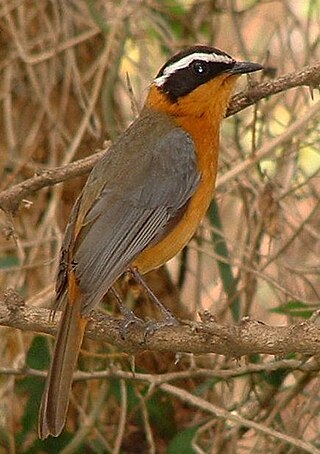
The white-browed robin-chat, also known as Heuglin's robin, is a species of bird in the family Muscicapidae. Found in east, central and southern Africa, its natural habitats include riverine forest and thickets, and it is also found near humans. The IUCN classifies it as a least-concern species.

The white-browed scrub robin, also known as the red-backed scrub-robin, is a species of bird in the family Muscicapidae. It is native to sub-Saharan Africa, especially East and southern Africa. Within range, its Turdus-like song is one of the often-heard sounds of the bush. The flitting of the tail is characteristic of this species, but also of some near relatives.

The yellow-throated longclaw is a species of bird in the family Motacillidae.

The little spotted woodpecker or green-backed woodpecker, is a species of bird in the family Picidae. It is native to large parts of tropical central Africa. It has an extensive range and is an uncommon species, and the International Union for Conservation of Nature has rated its conservation status as being of "least concern".

Precis is a genus of nymphalid butterflies that Jacob Hübner described in 1819. They are commonly known as commodores and are found in Africa. Two species are endemic to Madagascar.
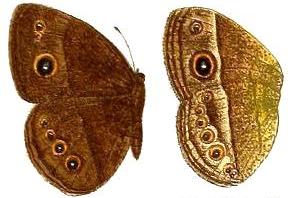
Heteropsis perspicua, the eyed bush brown, swamp patroller or marsh patroller, is a butterfly of the family Nymphalidae. It is native to eastern and southern Africa, but a western subspecies is present in Cameroon.

Sevenia boisduvali, the Boisduval's tree nymph, is a butterfly in the family Nymphalidae. There are four subspecies; all native to Africa.
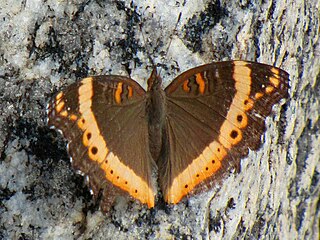
Precis archesia, the garden inspector or garden commodore, is a species of butterfly in the family Nymphalidae, native to Subsaharan Africa.
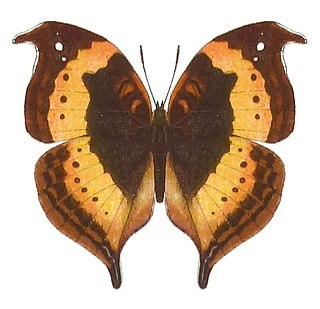
Precis tugela, the African leaf butterfly or eared commodore, is a butterfly of the family Nymphalidae. It is found in eastern and southern Africa, ranging from Ethiopia to South Africa. It is commonly included in the genus Junonia rather than Precis.
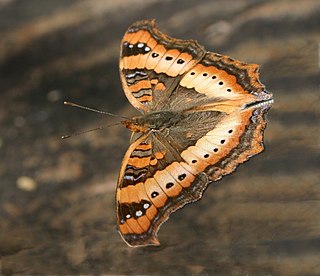
Precis ceryne, the marsh commodore, is a species of butterfly in the family Nymphalidae, native to Subsaharan Africa.

Protogoniomorpha parhassus, the forest mother-of-pearl or common mother-of-pearl, is a species of Nymphalidae butterfly found in forested areas of Africa.

Dixeia pigea, the ant-heap small white or ant-heap white, is a butterfly in the family Pieridae that is native to Africa.
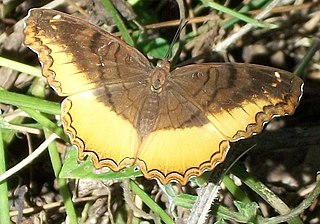
Eurytela dryope, the golden piper, is a butterfly of the family Nymphalidae, found in Sub-Saharan Africa, the Arabian peninsula and Madagascar.

Precis pelarga, the fashion commodore, is a species of butterfly in the family Nymphalidae which is native to tropical sub-Saharan Africa.

























